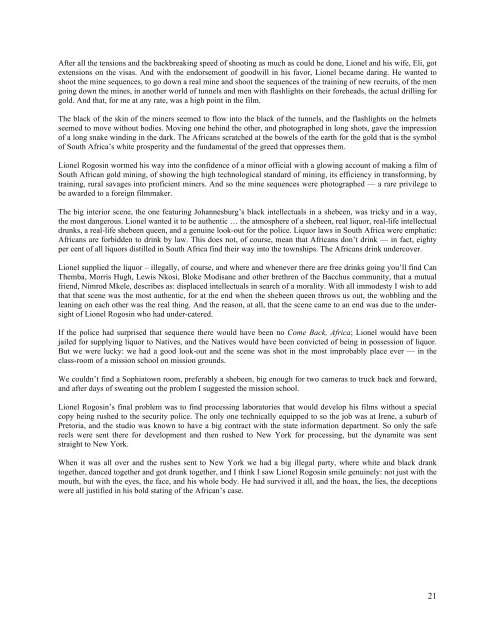Come Back Africa Press Kit - Get a Free Blog
Come Back Africa Press Kit - Get a Free Blog
Come Back Africa Press Kit - Get a Free Blog
Create successful ePaper yourself
Turn your PDF publications into a flip-book with our unique Google optimized e-Paper software.
After all the tensions and the backbreaking speed of shooting as much as could be done, Lionel and his wife, Eli, got<br />
extensions on the visas. And with the endorsement of goodwill in his favor, Lionel became daring. He wanted to<br />
shoot the mine sequences, to go down a real mine and shoot the sequences of the training of new recruits, of the men<br />
going down the mines, in another world of tunnels and men with flashlights on their foreheads, the actual drilling for<br />
gold. And that, for me at any rate, was a high point in the film.<br />
The black of the skin of the miners seemed to flow into the black of the tunnels, and the flashlights on the helmets<br />
seemed to move without bodies. Moving one behind the other, and photographed in long shots, gave the impression<br />
of a long snake winding in the dark. The <strong>Africa</strong>ns scratched at the bowels of the earth for the gold that is the symbol<br />
of South <strong>Africa</strong>’s white prosperity and the fundamental of the greed that oppresses them.<br />
Lionel Rogosin wormed his way into the confidence of a minor official with a glowing account of making a film of<br />
South <strong>Africa</strong>n gold mining, of showing the high technological standard of mining, its efficiency in transforming, by<br />
training, rural savages into proficient miners. And so the mine sequences were photographed — a rare privilege to<br />
be awarded to a foreign filmmaker.<br />
The big interior scene, the one featuring Johannesburg’s black intellectuals in a shebeen, was tricky and in a way,<br />
the most dangerous. Lionel wanted it to be authentic … the atmosphere of a shebeen, real liquor, real-life intellectual<br />
drunks, a real-life shebeen queen, and a genuine look-out for the police. Liquor laws in South <strong>Africa</strong> were emphatic:<br />
<strong>Africa</strong>ns are forbidden to drink by law. This does not, of course, mean that <strong>Africa</strong>ns don’t drink — in fact, eighty<br />
per cent of all liquors distilled in South <strong>Africa</strong> find their way into the townships. The <strong>Africa</strong>ns drink undercover.<br />
Lionel supplied the liquor – illegally, of course, and where and whenever there are free drinks going you’ll find Can<br />
Themba, Morris Hugh, Lewis Nkosi, Bloke Modisane and other brethren of the Bacchus community, that a mutual<br />
friend, Nimrod Mkele, describes as: displaced intellectuals in search of a morality. With all immodesty I wish to add<br />
that that scene was the most authentic, for at the end when the shebeen queen throws us out, the wobbling and the<br />
leaning on each other was the real thing. And the reason, at all, that the scene came to an end was due to the undersight<br />
of Lionel Rogosin who had under-catered.<br />
If the police had surprised that sequence there would have been no <strong>Come</strong> <strong>Back</strong>, <strong>Africa</strong>; Lionel would have been<br />
jailed for supplying liquor to Natives, and the Natives would have been convicted of being in possession of liquor.<br />
But we were lucky: we had a good look-out and the scene was shot in the most improbably place ever — in the<br />
class-room of a mission school on mission grounds.<br />
We couldn’t find a Sophiatown room, preferably a shebeen, big enough for two cameras to truck back and forward,<br />
and after days of sweating out the problem I suggested the mission school.<br />
Lionel Rogosin’s final problem was to find processing laboratories that would develop his films without a special<br />
copy being rushed to the security police. The only one technically equipped to so the job was at Irene, a suburb of<br />
Pretoria, and the studio was known to have a big contract with the state information department. So only the safe<br />
reels were sent there for development and then rushed to New York for processing, but the dynamite was sent<br />
straight to New York.<br />
When it was all over and the rushes sent to New York we had a big illegal party, where white and black drank<br />
together, danced together and got drunk together, and I think I saw Lionel Rogosin smile genuinely: not just with the<br />
mouth, but with the eyes, the face, and his whole body. He had survived it all, and the hoax, the lies, the deceptions<br />
were all justified in his bold stating of the <strong>Africa</strong>n’s case.<br />
21


